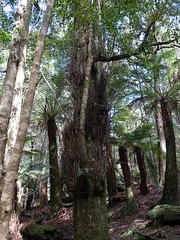Wakehurst Place and Gardens near Haywards Heath, West Sussex.
It's three years since we last visited this garden ... definitely time for another walk round. They are doing major restoration work on the house, but the gardens are looking good.
There have been some changes here and there. There was a woven willow sculpture trail in one area of woodland. It was still a bit early for the peak of the autumn leaf colour, but it's beginning. The prairie meadow is coming along nicely. The first few fungi were appearing. And lots of cheeky pheasants and other birds!
Phyllocladus, the celery pines, is a small genus of conifers, now usually placed in the family Podocarpaceae. Species occur mainly in New Zealand, Tasmania, and Malesia in the Southern Hemisphere, though P. hypophyllus ranges into the Philippines, a short way north of the equator.
They are small to medium-sized trees, or sometimes small shrubs. The main structural shoots are green for 2–3 years, then turn brown as the bark thickens. The leaves are sparse, tiny, scale-like, and only green (photosynthetic) for a short time, soon turning brown. Most photosynthesis is performed by highly modified, leaf-like short shoots called phylloclades; these develop in the axils of the scale leaves, and are simple or compound (depending on species).
Phyllocladus aspleniifolius, commonly known as the celerytop pine, is an endemic gymnosperm of Tasmania, Australia. It is widespread and common in Tasmania, with the most abundance in the western highlands. Its ‘leaves’ appear similar to those of a celery plant, hence the common name.
This species is rare in cultivation, and is limited to botanic gardens and arboreta and a few private gardens.



















